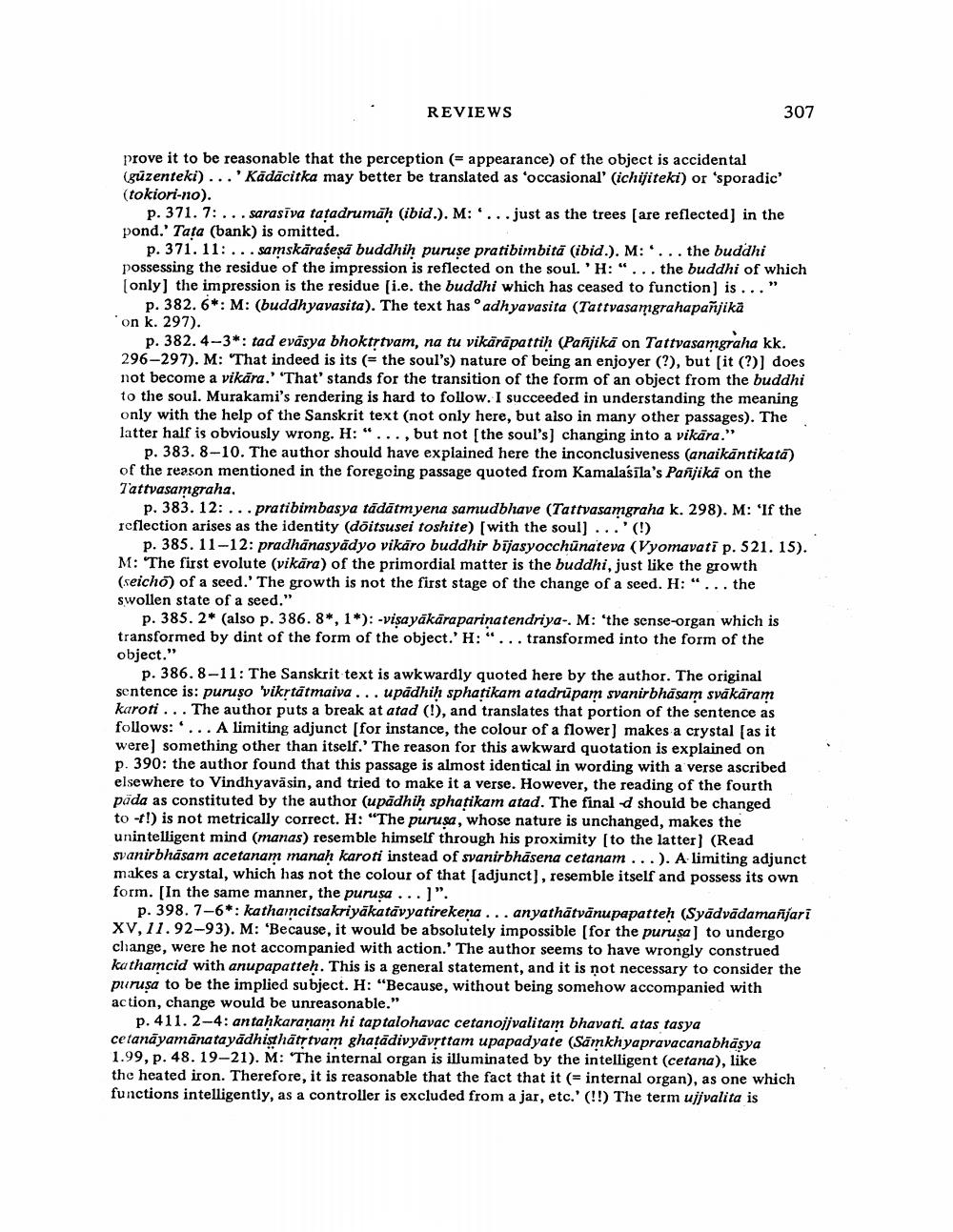________________
REVIEWS
prove it to be reasonable that the perception (= appearance) of the object is accidental (güzenteki)... Kādacitka may better be translated as 'occasional' (ichijiteki) or 'sporadic' (tokiori-no).
307
p. 371. 7:...sarasīva taṭadrumāḥ (ibid.). M: ... just as the trees [are reflected] in the pond.' Tata (bank) is omitted.
p. 371. 11:...samskäraseṣā buddhiḥ puruse pratibimbitā (ibid.). M: ... the buddhi possessing the residue of the impression is reflected on the soul. 'H: "... the buddhi of which [only] the impression is the residue [i.e. the buddhi which has ceased to function] is..." p. 382. 6*: M: (buddhyavasita). The text has adhyavasita (Tattvasamgrahapañjikā 'on k. 297).
p. 382.4-3*: tad evasya bhoktṛtvam, na tu vikārāpattiḥ (Pañjikā on Tattvasamgraha kk. 296-297). M: That indeed is its (= the soul's) nature of being an enjoyer (?), but [it (?)] does not become a vikara.' 'That' stands for the transition of the form of an object from the buddhi to the soul. Murakami's rendering is hard to follow. I succeeded in understanding the meaning only with the help of the Sanskrit text (not only here, but also in many other passages). The latter half is obviously wrong. H: "..., but not [the soul's] changing into a vikāra."
p. 383. 8-10. The author should have explained here the inconclusiveness (anaikantikatā) of the reason mentioned in the foregoing passage quoted from Kamalasīla's Pañjikā on the Tattvasamgraha.
p. 383. 12:... pratibimbasya tādātmyena samudbhave (Tattvasamgraha k. 298). M: 'If the reflection arises as the identity (doitsusei toshite) [with the soul] ...' (!)
p. 385. 11-12: pradhanasyadyo vikaro buddhir bijasyocchūnateva (Vyomavati p. 521. 15). M: The first evolute (vikara) of the primordial matter is the buddhi, just like the growth (seicho) of a seed.' The growth is not the first stage of the change of a seed. H: “ . . . the swollen state of a seed."
p. 385. 2 (also p. 386. 8*, 1*): -viṣayakaraparinatendriya-. M: 'the sense-organ which is transformed by dint of the form of the object.' H: "... transformed into the form of the object."
p. 386.8-11: The Sanskrit text is awkwardly quoted here by the author. The original sentence is: puruso 'vikṛtātmaiva... upadhiḥ sphaṭikam atadrupam svanirbhasam svākāram karoti... The author puts a break at atad (!), and translates that portion of the sentence as follows: ... A limiting adjunct [for instance, the colour of a flower] makes a crystal [as it were] something other than itself.' The reason for this awkward quotation is explained on p. 390: the author found that this passage is almost identical in wording with a verse ascribed elsewhere to Vindhyaväsin, and tried to make it a verse. However, the reading of the fourth pada as constituted by the author (upadhiḥ sphaṭikam atad. The final -d should be changed to -t!) is not metrically correct. H: "The purusa, whose nature is unchanged, makes the unintelligent mind (manas) resemble himself through his proximity [to the latter] (Read svanirbhasam acetanam manaḥ karoti instead of svanirbhasena cetanam...). A limiting adjunct makes a crystal, which has not the colour of that [adjunct], resemble itself and possess its own form. [In the same manner, the purusa...]".
p. 398. 7-6*: kathamcitsakriyakatāvyatirekena... anyathātvänupapatteḥ (Syādvädamañjarī XV, 11.92-93). M: 'Because, it would be absolutely impossible [for the purusa] to undergo change, were he not accompanied with action.' The author seems to have wrongly construed kathamcid with anupapatteḥ. This is a general statement, and it is not necessary to consider the purusa to be the implied subject. H: "Because, without being somehow accompanied with action, change would be unreasonable."
p. 411. 2-4: antahkaranam hi taptalohavac cetanojjvalitam bhavati, atas tasya cetanayamanatayadhisthätṛtvam ghaṭādivyavṛttam upapadyate (Samkhyapravacanabhāṣya 1.99, p. 48. 19-21). M: The internal organ is illuminated by the intelligent (cetana), like the heated iron. Therefore, it is reasonable that the fact that it (= internal organ), as one which functions intelligently, as a controller is excluded from a jar, etc.' (!!) The term ujjvalita is




